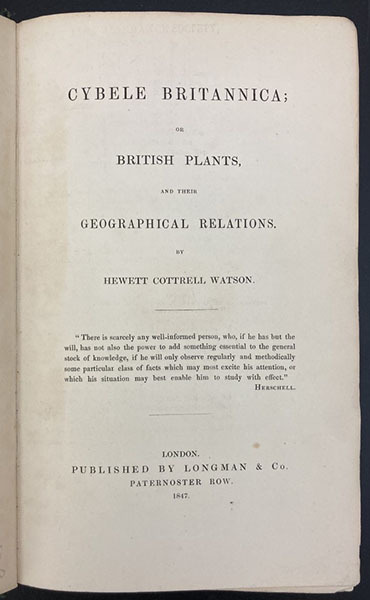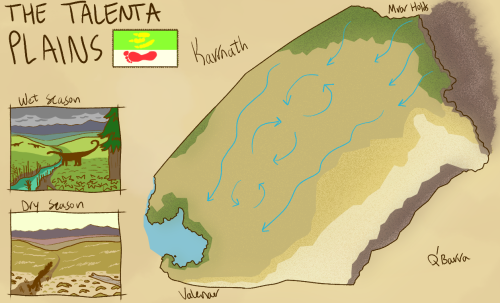#biogeography
Oh, the seasons they grow! First thesis chapter published. [research blog]

My latest clamuscriptis published in Palaios, coauthored with my advisor Matthew Clapham! It’s the first chapter of my PhD thesis, and it’s titled “Identifying the Ticks of Bivalve Shell Clocks: Seasonal Growth in Relation to Temperature and Food Supply.” I thought I’d write a quick post describing why I tackled this project, what I did, what I found out, and what I think it means! Raw…
Hewett Cottrell Watson – Scientist of the Dy
Hewett Cottrell Watson, an English botanist, was born May 9, 1804.
read more…
Post link
The Talenta Plains are the largest remnants of a bygone era, before the proliferation of angiosperms. Flowering plants first evolved on Sarlona in conjunction with the extinction of the dinosaurs of the continent. Possibly the cause of said extinction. For a while they lived exclusively on the Eastern continent, slowly proliferating to the nearby Argonesson and Lhazaar Principalities. With the third land-bridge between Frostfell, Sarlona, and Khorvaire came an exchange of both fauna and flora. By chance flowering plants got their first foothold on Khorvaire. Especially grass. These plants spread throughout the continent and gradually faded the gymnosperms out. Mammals, being better adapted to consume angiosperms, replaced the once dominant dinosaurs. Only a handful of locations exist on Khorvaire where they can be found freely, the Talenta Plains being the largest.
Gymnosperms and their saurian consumers retain their position due to their ecological stability. And even then some angiosperms have invaded. Talenta is an interesting case, as grasses, almost omnipresent elsewhere, are completely absent. Instead the “plains” of Talenta are faux savannas made up of short ferns and terrestrial horsetail relatives. Floodplains dominant Talenta, leading to the binomial name of the nation. While enormous, larger than any other biome on the continent, they do not alone make up Talenta. To the South and East the Blade Desert sits. A narrow sea used to exist on Khorvaire millions of years ago, bounded by the Ironroot and (formerly shorter) Endwall Mountains. This sea flooded much of low-lying Talenta and Valenar. Eventually it dried up and was replaced by long prairies of ferns adapted to the salty soil. The Blade Desert facing the Endwall mountains, however, did not recover with plants. A rain-shadow effect produced a long desert where the salt never truly left. This is a lifeless land devoid of even plants, made up of dry soil and a white covering of salt. The Ironroot Mountains are a different story. They provide enormous amounts of snow melt. Water carries from these mountains, through Talenta, until it dumps into Lake Cyre. Hugging the mountains is a vast gymnosperm forest that makes the easternmost portion of Talenta. A similar forest sits on the Northwestern edge of Talenta, stretching into Karrnath and formerly Cyran territory.
Talenta’s plains are characterized by the yearly cycle of water flow from the Ironroot mountains. Wet and dry seasons are incredibly distinct, so much so that the native halflings have based their calendars around it, creating five month-long dry and wet “years”. In the dry season Talenta is similar to the savannas of Sarlona. Ferns grow short and skimp on producing chlorophyll, making the plains a wide yellow expanse. Rivers and lakes still flow, but at a much smaller rate. During this period animals make a migration around the plains to not exhaust the plant resources in one area. The foremost players are sauropods. At every step in the cycle they rid the plains of any and all mid to high growing trees. Behind them they leave bare wooden spears and the short-growing ferns, which smaller herbivores feed upon. Following the sauropods are the large carnivores. With the wet season comes the renewal of plant life all across the plains. Talenta’s odd soil composition and the presence of huge herds of dinosaurs crossing it constantly means the ground is highly changeable. Rivers rarely flow along the same path they did last wet season, snaking through the turbulent soil to make new riverbeds. Where they cannot flow they create ephemeral lakes that, depending on the ground, can become quite deep and deceptively narrow. Walking along the plains at any season, but especially the wet season, is a nightmare. Nowhere is the ground flat enough to support horses or wheels or rails. Stepping on what looks like grass could lead to a hidden hole grown over by ferns. It’s no wonder the small, light-footed halflings are the only ones who call this place home. Wet seasons usually spell a short rest to the cycle of migration, as dinosaurs start to mate, make nests, and raise their young. Once this is over the waterways dry up, all except the largest, and the migration continues. Any lakes or ponds will either evaporate or become stable and stranded, growing ever more stagnant and muck-filled. Here amphibians and hardy fish wait out the next wet season.
This way of life, characterized by the constant shifting of landmarks and cycles of water flow, have created a dichotomously chaotic and predictable environment. Animal groups extinct elsewhere thrive in Talenta, changing ever so slowly. Which isn’t to say it is not free from change. Halflings, the first humanoid species to come to Khorvaire, shook up the ecosystem quite a bit. They slotted into the migratory cycles easily, following the fastieth, dinosaurs known in Common as camptosaurs, dryosaurs, and their relatives. Any notion of hunting sauropods is the realm of Talenta myths and legends. At some point in this cycle the halflings domesticated the swift, small-bodied fastieth known as dryosaurs. These mounts are much smaller than horses but perfect for the little folk to ride and take hunting. Their three-toed, splayed feet make running across the uneven plains a breeze, and riders will leap from their saddles in tandem with the bumps of their mounts to create a rhythm. When this domestication event happened is unknown, but it may have been earlier than the first Dhakaani empires. Fastieth and other members of the Talenta menagerie figure into the beliefs of the halflings almost as easy as they figure into their daily lives. During the signing of the Treaty of Thronehold the Talenta delegation showed up with a flag bearing two footprints: one halfling and one fastieth.
–
Hello! This is a continuation of that biogeography/ecology series. While DM-ing an Eberron campaign for about a year now I have written a shit-ton of stuff. Mostly to put all the information in one place so I don’t have to keep switching to the Eberron wiki in games, but also for my own ideas and world-building. And because I’m me, the dinosaurs have been a big part of that. The Talenta Plains are, I’ve decided, basically just the Morrison Formation. This, and what follows, are what I’ve written about it. Eberron originally belongs to D&D and Keith Baker.
Post link






